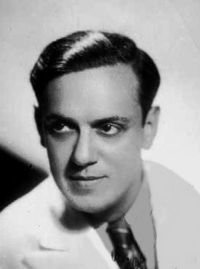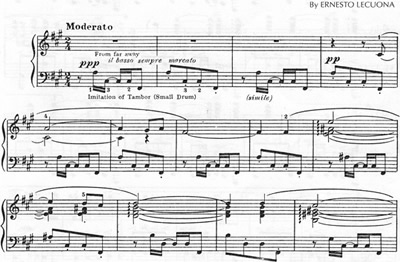You are hanging around, sitting outside a Cuban cafe in Havana in the 1930s, sipping a cold mint tea sweetened with sugar cane juice, enjoying the lethargic hours of the tropical evening. Suddenly you hear a faint drum, beating a hypnotic pattern. It’s slowly getting closer to you. You know there will be consequences. This sensuous Afro-Cuban music is hard to ignore. It takes over your body.
As the music draws near, you realize it’s a Carnival procession, with drums, singing and masked, colorful dancers. It slowly engulfs you with its contagious rhythms, captures you in the midst of the buoyant crowd, and then, gradually goes away, until the only thing you can hear is the faint sound of the drum, droning away its syncopated pattern. You go back to enjoying your drink and the scented humid air.
This is exactly how Lecuona’s piano composition “La comparsa” feels to me. This 3-minute piece starts quietly in the left hand — an “imitation of a drum” reads the score. A haunting, distant melody enters in the right hand. Gradually things get heated, with octaves and more syncopations in both hands. The piece fades away back to the original left hand pattern and ends quietly.
The piece is one of Lecuona’s best known. Originally it contained lyrics, but there are many instrumental versions. It has been adapted and transcribed into many settings. Musicians as diverse as Eddie Palmieri, Chucho Valdez, Manuel Barrueco, Placido Domingo and Carlos Barbosa-Lima have recorded it.
 The Cuban composer, pianist and child prodigy Ernesto Lecuona (1895-1963) was trained as a classical musician, but quickly became interested in Cuban and Spanish rhythms. He made a career in the semi-classical world of Zarzuelas (Spanish operetas), and was also a successful Hollywood movie composers — he was nominated for an Oscar for his “Always in My Heart” in 1942, which lost against “White Christmas” by Irvin Berlin.
The Cuban composer, pianist and child prodigy Ernesto Lecuona (1895-1963) was trained as a classical musician, but quickly became interested in Cuban and Spanish rhythms. He made a career in the semi-classical world of Zarzuelas (Spanish operetas), and was also a successful Hollywood movie composers — he was nominated for an Oscar for his “Always in My Heart” in 1942, which lost against “White Christmas” by Irvin Berlin.
Lecuona is best known for his “Malagueña” for piano (please check this link for the correct pronunciation of this word, which is mispronounced 99% of the time in the US!!!). “Malagueña” is a piece that unfailingly fascinates enthusiastic teenage piano students looking for exciting and flashy “Spanish” repertoire. Unfortunately for their teachers, “Malagueña” is a very difficult piece that not many young pianists can handle!
“Malagueña” definitely sounds Spanish and Andalusian – not Cuban at all. Regrettable, Lecuona’s other Cuban compositions are not as well known as this Spanish-style piece – they deserve to be played more often. He wrote many pieces within the technical reach of intermediate teenage pianists. “La comparsa” belongs to one such sets, Danzas Afro Cubanas, or Afro-Cuban Dances. Other exciting pieces in this set: Danza Lucumi and Danza de los Nanigos.
Buy it at SheetMusicPlus.com:
| Danzas Afro-Cubanas Piano Solo. By Ernesto Lecuona. Piano. Size 9×12 inches. 24 pages. Published by Marks. (9248) See more info… |
I also recommended a collection that contains all his piano works (including Malagueña and La comparsa) in one volume of 192 pages.
Buy it a SheetMusicPlus.com:
 |
Ernesto Lecuona: Ernesto Lecuona Piano Music Composed by Ernesto Lecuona (1895-1963). Collection for solo piano. 192 pages. Published by Edward B. Marks Music. (HL.220002) See more info… |
Like the lyrics of “La comparsa” say: this music will “engage your whole body with its harmonious and sensuous rhythm, and will give you shivers with its magical sounds.”
Take a look at Thomas Tirino playing “La comparsa” (YouTube video)

